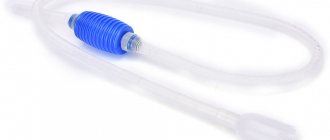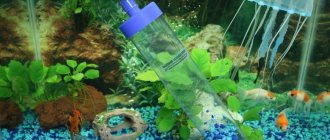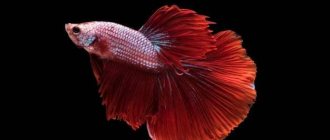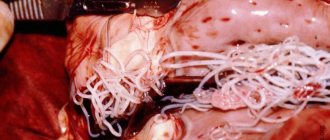Soil cleaning methods
Two main methods are used to clean soil:
- using a dirt suction device (or siphon);
- removing soil from the aquarium and placing it in a specially selected container, followed by rinsing under running water.
As a rule, the first cleaning option is used because it is less labor-intensive and does not take much time. You can extend the procedure over several days by dividing the bottom area into sections and sequentially treating one or two per day.
Cleaning with soil extraction requires greater efficiency, since the fish are temporarily resettled and are in unusual conditions. This can greatly harm the inhabitants of the aquarium, therefore, they try to complete the cleaning procedure as soon as possible.
Cleaning a marine aquarium
If you want to thoroughly clean an ordinary marine tank, which is usually filled with various decorative elements, you will need to follow these rules:
- Decorations can be cleaned inside the aquarium with a stiff brush or outside with a sponge;
- Modern detergents and household cleaners are not used;
- Be sure to remove all algae damaged by crawling snails or fish. You also need to get rid of eaten leaves. The plant should not complicate the movement of aquatic inhabitants;
- If you do not plan to change the water during harvesting, you need to weed out the bushes very carefully, without raising the turbidity.
To save yourself from regular and tedious weeding, you should get special algae-eating fish. They will keep the water clean for a long time. If you use an additional magnet to clean the aquarium, you can get the best option for cleanliness.
If plants grow very quickly, if they acquire a brown tint, this indicates an unfavorable situation in the reservoir. It will be necessary to take certain measures to effectively control lower plant species.
How does a siphon for an aquarium work?
A mud pump, soil cleaner or siphon for an aquarium is a device consisting of several elements:
- transparent tube or funnel;
- flexible hose (rubber or PVC);
- pump with electrical or mechanical drive.
The general principle of operation is the same in any case - a transparent funnel is placed on the ground, water along with contaminants enters it and through a flexible hose enters a special trap (this is a small reservoir located immediately after the pump).
The water either enters a separate container, from which, after filtration, it returns to the aquarium, or it immediately goes back, passed through a mesh filter.
Mechanically driven siphons are cheaper, but the cleaning process with them is more labor-intensive; you have to manually operate the pump and filter the removed water before returning it to the aquarium. Siphons with an electric motor are more convenient to use, but somewhat more expensive.
1 - Mechanical siphon 2- Siphon with electric motor
As a rule, mechanical devices are preferred by owners of relatively small aquariums, while electric ones are purchased for large containers that require lengthy and thorough processing. At the same time, there is a limitation on the height of the walls - if they are higher than 50 cm, water can be poured into the battery compartment of the siphon.
In addition, you need to pay attention to the height of the glass (funnel). It is recommended to choose models with a suction part height of at least 20 cm. Then large soil particles will settle to the bottom without entering the hose and container with water or filtrate. This is an important point, since otherwise the amount of soil will decrease with each cleaning and require regular replenishment.
You should purchase siphons with a transparent tube (funnel) to control the cleaning process and stop it in time.
Why does an aquarium get dirty?
Watching the fish calms you down, improves your mood and allows you to promptly notice changes that have occurred in them, indicating that it is time to wash the aquarium. Gradually, the water becomes cloudy, small debris appears in it, and plaque accumulates on the walls, bottom, and soil. These troubles are associated with the life activity of the inhabitants, the presence of algae, and water quality.
The main causes of pollution are the following:
- Overfeeding . If the fish do not eat the food, its remains sink to the bottom and rot.
- Mistakes when decorating . Unprepared soil causes turbidity to appear in the water. Before use, rinse it thoroughly, rinse the shells or figurines used for decoration, and remove fine dust from them.
- Reproduction of microorganisms . Aquarium water necessarily contains bacteria and fungi, which provide benefits by processing ammonia, nitrates and other dangerous substances. But an increase in their number causes a disturbance in the biological balance and the appearance of turbidity. When starting an aquarium, the water needs to be left for several days and only then repopulated.
- Rapid development of algae . This does not mean those plants that sway beautifully and serve as decoration, but lower organisms. They turn the water green and settle on the walls.
- Overcrowding and poor filtration . There are standards regulating the dependence of the number of fish on the volume of water. If there are too many inhabitants, the filter cannot cope, and the amount of waste products increases, causing cloudiness of the liquid.
How to fix it depends on the cause of the problem. You need to analyze the specific situation and decide how to clean the aquarium at home.
How is cleaning done?
You should use the siphon a few weeks after starting the aquarium, not earlier. Firstly, there will be no point in the procedure, since organic matter and food residues have not yet had time to accumulate. Secondly, the inhabitants of the aquarium are just getting accustomed to their new place, therefore, it is not advisable to disturb them.
The cleaning process, in addition to removing excess organic matter settled on the ground, involves removing part of the water. In some cases, it is filtered and returned back, in others it is simpler and topped up with clean water to the desired level.
Cleaning procedure:
- Prepare a siphon and a container for water (a regular bucket will do).
- Fill the siphon tube with water and immerse it in the aquarium. The free end must be lowered below the bottom level, otherwise the water will not flow by gravity (if an electric siphon model is used, this condition is not necessary).
- It is recommended to conditionally divide the bottom area into squares in advance so that cleaning is as thorough as possible. This especially applies to large aquariums.
- Using a tube, lightly stir up the soil, raising the turbidity. It is recommended to immerse it to the very bottom (to the glass) in order to siphon the entire layer of backfill and remove organic matter with maximum efficiency.
- Heavier soil particles will settle to the bottom, and organic matter and fine suspension will be picked up by the water flow and discharged into the prepared container.
- The process is controlled by monitoring the state of the flow. As soon as the water in the tube has become clear, the procedure is transferred to the next section of the bottom (or stopped altogether).
The more powerful the siphon, the larger the tube diameter required. If the water leaves too intensively, the soil itself may be sucked in, which is undesirable. It is necessary to organize the process so that only organic matter and suspended matter are removed, and the backfill layer remains at the bottom.
Types of siphons for soil cleaning
Siphons consist of a long hose, a flask and a bulb designed to suck in liquid. Today in pet stores you can find a large number of models that differ from each other in a number of important qualities. Let's look at each of them.
Size:
- For tall aquariums;
- Standard;
- Small ones.
Principle of operation:
- Electric - they run on batteries, suck up dirty liquid and drain it into the sewer, or carefully filter it and return it back. Such models are intended for heavily polluted aquariums in which large changes cannot be made.
- Mechanical - operate using a pear and alternately raising/lowering the cylinder. Suitable for cleaning aquariums where the water level is no more than 0.5 m. More convenient to use, but short-lived.
Cleaning funnel shape:
- For the usual procedure - cone-shaped;
- For hard-to-reach areas (for example, spaces between stones and snags) - with a narrowed tube.
The larger the cross-section of the tube, the more powerful the water pressure.
If you close the tip of the tube with a strainer, large fractions will remain in place, and waste will go away.
It is better to use a transparent hose - this way you can observe the cleaning process.
Pros and cons of using a siphon for an aquarium
The positive aspects of cleaning soil using a siphon include:
- the ability to remove decaying organic particles;
- the danger of acidification of the substrate, which does not receive oxygen, is eliminated;
- the bad odor is eliminated, no harmful gases are released from the soil.
Flaws:
- the number of bacteria living in the upper layers of the substrate decreases, which leads to a decrease in biofiltration ability;
- Nutrients are removed from the soil, which worsens the conditions for keeping plants;
- there is a risk of damage to the roots of aquatic plants.
When choosing a method for cleaning an aquarium, you need to weigh all the pros and cons so as not to disturb the ecosystem and not worsen the living conditions of fish and other organisms.
How to clean with hydrogen peroxide?
In special situations, it is necessary to use hydrogen peroxide when cleaning the tank. This composition may be required in such situations as:
- Fish diseases.
- Rapid spread of algae.
- Accidental overturning of a can of food.
- One of the fish died, which went unnoticed.
- The filters did not work for a long time.
The use of the composition will saturate the water with a large amount of oxygen. At the same time, oxidation of organic matter will be observed, a large amount of which is quite harmful to the inhabitants of the reservoir.
To achieve a positive effect when using peroxide, you will need to first dilute the composition in a small container, in a ratio of approximately 1:15. It is strictly forbidden to pour pure pharmaceutical composition into the tank; there is a great danger of burning the living inhabitants. The solution is poured from a syringe in a thin stream into the filter, which will gradually release it into the water and produce its beneficial effect.
After about half an hour or an hour, it will be possible to perform a water change to finally remove all elements of dead organic matter that can cause rot.
Which soil is most in need of cleaning?
Mostly soil without plants needs cleaning. It is recommended to siphon it monthly (in small aquariums you can repeat the procedure twice a month, sometimes 3 times a week). This will help maintain the concentration of nitrates and phosphates at a safe level.
Herbalists siphon much less often - once a year, or even less often. The fact is that plants form an ecosystem with a closed consumption cycle. The settling particles of organic matter and decomposition products become a nutrient medium for plants and do not require frequent cleaning. For cleaning, it is recommended to use a special metal tube with a flattened working end so as not to damage the roots.
Arend van den Nieuwenhuizen
Aquascaper
If nutrient soils are used as soil, siphon cleaning cannot be used. During the cleaning process, nutrients will be removed from the granules and sludge containing useful substances will be removed. Soils are not washed at all, even before adding them to the aquarium. This allows you to preserve the working qualities of the soil, the service life of which is already quite short (it is generally accepted that the service life of soils does not exceed 1.5-2 years).
— Arend van den Nieuwenhuizen Aquascaper
If the amount of organic matter in the soil begins to worry, and siphoning is not possible, it is recommended to add shrimp or snails that can destroy excess waste and silt.
When should you not siphon soil in an aquarium?
There are several situations in which it would be better to avoid cleaning the soil with a siphon:
- The aquarium is densely planted with flora and inhabited by a large number of snails, fry and shrimp.
- The aquarium is used only for aquatic plant species
- The aquarium was launched less than 2 weeks ago.
To make sure that the soil with plants needs to be siphoned, stir it. If foul-smelling air bubbles appear and cloudiness begins to rise, it’s time to start cleaning. This indicates that a lot of organic decay products have accumulated in the aquarium, which can harm the fish.
Making a siphon with your own hands
The price of a regular mechanical siphon is in the range of 500-700 rubles. This is quite affordable for aquarists, but many prefer to make siphons themselves, not wanting to waste time searching or waiting for the device to be delivered from online stores.
For a homemade siphon you will need:
An empty plastic bottle (0.5 l) with a lid, preferably transparent.
Shoe knife.
A piece of hard plastic hose 50-60 cm long.
1.5-2 m of flexible hose with a diameter of 10 mm.
To make a siphon, you must perform the following steps:
- The plastic bottle is cut so that a funnel of the required diameter is formed. For more active water suction, the edges can be made jagged.
- A hole is made in the lid for connection to a rigid tube. An adapter is installed on the free end to connect a flexible hose.
- All connections are sealed with electrical tape (you can use silicone sealant).
At this point, the production of a simple siphon can be considered complete.
average cost
As of February 2022, the average price of equipment in online stores is:
GC-30 620 rub.
GC-40 890 rub.
GC-50 990 rub.
The manufacturer supplies spare parts for siphons, the customer can purchase a new hose or tube sections. The cost of Tetra components is comparable in price to new equipment; a number of customers note a long delivery time for parts.
Frequently asked questions
Let's consider some questions that novice aquarists constantly have regarding the procedure for cleaning the soil with a siphon:
Do I need to remove driftwood and other decorative elements before cleaning?
It is not advisable to touch snags. If access to some areas is difficult, it is recommended to use a special funnel attachment with a curved and thinner tube.
Do I need to remove the fish before using the siphon?
No, there is no need to remove the inhabitants of the aquarium, but you must act carefully, trying to protect the fish from getting inside the funnel.
When can you siphon an aquarium for the first time?
No earlier than 14 days after launch (in practice, this period is often extended to a month or more).
How to reduce the frequency of soil cleaning?
To reduce the frequency of cleaning, it is recommended to reduce the number of fish and plant the aquarium with plants with a strong root system. In such conditions, you can do without using a siphon altogether.
What should be done if the siphon does not absorb water well?
You can increase suction by changing the diameter of the funnel. The smaller it is, the greater the water suction force. However, you should not reduce the size of the funnel too much, otherwise it will begin to draw in soil.
How to visually determine that it is time to siphon the soil?
Rotten plant roots indicate the need for cleaning. In addition, you can perform a test using a stick immersed in the ground. If gas bubbles come out of it, then it’s time to siphon the aquarium.
Cleaning an aquarium using a siphon allows you to quickly and without special preparation remove waste and food residues that have settled on the ground. The procedure is quite simple and does not require the use of complex equipment - you can make a siphon yourself.
There are some contraindications that you need to know about in advance (using a siphon in herbalists or cleaning soils). A correctly performed procedure will allow you to establish a comfortable habitat for the fish and eliminate the bad smell from the aquarium.
We clean an aquarium professionally at home: materials
In all domestic ponds, without exception, a special coating appears on the walls. This makes the glass untidy. To avoid this, algae must be removed. To solve the question of how to clean an aquarium at home, materials such as:
- Plastic scraper equipped with a sharp metal blade. If you don’t have it, you can replace it with regular stationery knives;
- Kitchen sponge;
- Special magnetic tool.
A scraper or a knife purchased at the office is convenient because it removes dirt on glass very well and quickly. If the structure is made of plexiglass, this tool will not work; it will scratch it.
The magnetic tool is ideal for fairly deep containers and those with limited top access. The tool is suitable for modern plexiglass and eliminates the need to drain water before cleaning. The only downside is the overall difficulty in thoroughly cleaning the corners of the container and the edge of the underside of the glass.
The most economical option is to use a standard washcloth, but it forces you to reach all areas with your hand when washing, and its structure is also not suitable for cleaning plexiglass. The algae deposit removed using the selected tool does not need to be caught and then waste time on the cleaning process. The fish will have time to consume a little, and the rest will be removed when drained.
Rules for surface cleaning of an aquarium
When carrying out routine or superficial cleaning of the aquarium, adhere to some rules and procedures:
- disconnect electrical appliances from the network. Leave external filters;
- clean plaque from glass with a scraper or sponge;
- If the decorations are covered with plaque, take them out and rinse with hot water. Use any detergent, but rinse thoroughly;
- trim living plants, do weeding;
- siphon the soil as necessary;
- drain the water (if you are cleaning the bottom, this will be done automatically);
- rinse the filter as necessary;
- fill with clean water.
After the water has settled, brush over the decorations and shake off the residue.
What happens when soil siphons?
In the soil, detritus with a fraction of 2-5 mm clogs the empty space and the environment becomes slightly anaerobic, which has a good effect on plant growth. Bacteria live on the surface of the soil and process organic residues. During siphoning, the upper part of the soil sinks down and nitrifying bacteria die. There are problems with nitrites and ammonia in the container. Nitrifying bacteria need time to recover.
During cleaning with a siphon, a lot of sludge gets into the water, the water becomes cloudy, which leads to the release of ammonium and organic matter into the water. This in turn leads to the appearance of filamentous algae, blackbeard or flip flops. Therefore, there is no need to overdo it with cleaning.
If there is a lot of dirt in the aquarium, then do not rush to restart and wash the soil. Every other day, siphon well a small area of the container, approximately 15-20% of the bottom area. In this case, keep the siphon in one place longer than usual. Remove plants from the soil and plant them again after cleaning.
Please note that biofiltration will decrease and will be restored after a day. To reduce the load on the aquarium, the fish are not fed that day, and the next day they are given less food than usual. To quickly restore balance, you can add a culture of beneficial bacteria to the water.
What can you do to siphon less often?
To siphon the soil in the aquarium as little as possible, you should reduce the number of fish and increase the number of plants with a strong root system. It is important not to overfeed the inhabitants so that less food remains are formed. Soil with particles of the same size does not cake, the likelihood of such a substrate becoming sour is minimal, so it makes sense to choose just such a soil. The more conditions in the aquarium are met, the less often the siphon is done.
However, even under ideal conditions, a siphon will be a must-have item in the management of an artificial reservoir. It is necessary to siphon each aquarium at a certain frequency (except for the cases described above). Based on the characteristics of the reservoir being cleaned, as well as personal preferences, you can choose a convenient and affordable type of siphon for yourself.
Source
Principle of operation
Over time, the designs of all plumbing fixtures change, and the same applies to the siphon. However, no matter what design it acquires, the principle of operation of the siphon remains unchanged. The simplest diagram can be represented as follows:
- water enters the flask through the sink drain;
- passes through several pipes;
- some water remains in the sump;
- the rest of the water enters the sewer, passing through the outlet pipe;
- The water that settles in the sump creates a blockage, resulting in an unpleasant odor remaining in the sewer.
Siphon disassembled
If the device is installed correctly, the principle of operation of the siphon is not affected. There is an exception in which the smell may spread throughout the room. Here we are talking about the long absence of the owners of the apartment, when the sinks and bathtub are not used for a long time. In this case, an odor may appear in the room, but it can be easily eliminated by running water.
It is worth saying that this product consists of several elements, which are connected to each other by cone-shaped gasket sleeves. It is these gaskets that play an important role in the safety and performance of the device.
It is very important that the sleeves have sufficient plasticity. Poor quality gaskets can lead to sudden failure of the device, which will require repair or replacement of the entire siphon
What is it for?
Various models of aquarium siphons can rid the container of unwanted dirt at the bottom and provide the fish with a safe habitat. Uneaten food remains, silt and fish excrement fall to the bottom, polluting the water, causing poisoning and decreased immunity in the fish; in some breeds, the color fades and the level of activity decreases. For especially fastidious aquarium inhabitants, waste in the ground is deadly. The bottom soil should be cleaned as it gets dirty; the aquarist must carefully monitor the habitat of the pets.
Cleaning process
Cleaning with a siphon is a long and monotonous process. Hastily done work does not make sense; you need to clean the entire bottom area at one time.
Devices for cleaning soil differ in appearance, but the method of use remains the same. The aquarium liquid with debris flows by gravity into the tube and is discharged outside the tank for subsequent filtration.
When using a mechanical siphon, it makes sense to prepare a container for draining the liquid in advance. During the process, it is necessary to monitor the water level; you cannot drain more than 30% of the total water in the aquarium.
The filter must be lowered vertically onto the contaminated surface, and the device is activated. When the liquid inside the funnel becomes colorless, you can move to another section of the bottom soil. In this way, the entire lower part of the tank is processed. You need to carefully monitor the process - plants, stones or small fish can get into the mechanism
Areas with plants require special care, as the root system is easily damaged. The ideal solution would be to purchase a siphon model designed specifically for soil with thickets
The convenient nozzle cleans hard-to-reach areas without harming the plants. If there are decorations, then you should not be lazy and carefully siphon the soil underneath them.
Drilling into the ground will ensure high-quality cleaning, since less accessible layers of the stone coating are affected. The pressure force is set by immersing the tip of the tube. The lower the suction part is lowered, the stronger the pressure will be. To clean the soil in a small aquarium, you should not use a large soil cleaner; this can harm the plants and animals living there. When pumping out water, the outer part of the hose must fall quite low, otherwise drainage will not be possible (law of communicating vessels). The more inhabitants inhabit the aquarium, the more often the cleaning is done.
Biological organisms that clean aquariums
Toxic products (excrement, leftover food, plant waste) are neutralized and broken down by beneficial bacteria into a form suitable for plant nutrition.
Bacterial waste products are absorbed by filters or removed by water changes.
Plants purify water, absorb carbon dioxide, and release oxygen. Floating plants are considered the most active.
Among biological organisms, mollusks stand out. They convert calcium into an insoluble state, bring food residues to the desired consistency, and bacteria can easily process them in the future.
Amoebas prefer to feed on algae and organic debris. This gives food to bacteria.
The appearance of bryozoans in the vessel indicates a successful balance. Since they live only in clean water with a sufficient dose of oxygen.
All flora and fauna participate in the biological balance of the aquarium, but their importance is unequal.
Snails
Active algae fighters among snails:
- Helena;
- Corbicula java;
- Zebra;
- Black ear;
- Hedgehog;
- Porcelain septaria.
The temperature is in the range of 22-27 degrees.
Snails do not reproduce in a vessel, except for the “black ear” species. Caviar can be seen on the walls of the glass.
The horned snail Neritina Gliton lives among the fish for up to 5 years. The uniqueness of the species is its miniature size of 1-1.5 cm.
Fish
Cleaner fish benefit freshwater aquariums by:
- Siamese algae eaters;
- otocinclus;
- Ancistrus.
The main food of fish is algae. Content temperature is 23-26 degrees.
Shrimps
Shrimp are popular among aquarists:
- Amano;
- Crystal;
- Cherry;
- Black Tiger.
Shrimp destroy algae and rotting plant leaves.











